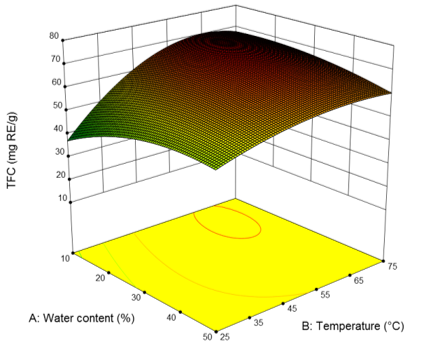EXTRACTION OF FLAVONOIDS FROM KOENIGIA WEYRICHII USING DEEP EUTECTIC MIXTURE OF CHOLINE CHLORIDE + GLYCERINE
UDC 577.127.4; 542.06
Abstract
Koenigia Weyrichii (F. Schmidt) T.M. Schust. et Reveal, which grows on the Kola Peninsula, contains a significant amount of flavonoids in the aerial parts of the plant, rapidly builds up biomass, and is resistant to various climatic conditions. This makes K. Weyrichii a promising source of biologically active substances (BAS) in the Arctic zone. A relatively new method for extracting biologically active substances from plants is the use of deep eutectic solvents (DES), for example, a mixture of choline chloride with glycerol, which has shown high efficiency in the extraction of flavonoids from other plants. Previously, DES was not used for the extraction of biologically active substances from K. Weyrichii. The aim of this work is to evaluate the efficiency of ultrasonic extraction using traditional solvents (water, ethanol) and DES choline chloride + glycerol and to optimize the extraction conditions. Comparison of the total content of polyphenols, flavonoids, antioxidative, and antiradical activity in various extracts is carried out. It was found that the most favorable conditions for extraction are: water content in DES – 17.5 wt%, temperature – 65 °C, and time – 3 hours. At the same time, under identical extraction conditions (temperature and time), more target substances can be extracted with 60% ethanol than with DES. However, DES can be seen as an alternative to using ethanol. The data obtained can be useful for the further development of innovative technologies of the extraction of biologically active substances from plant material. Also, K. Weyrichii may be considered as a source of biologically active substances in cosmetics and the food industry.
Downloads
Metrics
References
Hassannejad S., Ghafarbi S.P. Annu. Res. Rev. Biol., 2017, p. 1.
Schuster T.M. et al. Taxon. International Association for Plant Taxonomy, 2015, vol. 64, no. 6, p. 1188. DOI: 10.12705/646.5.
Korovkina A. et al. IOP Conf. Ser. Earth Environ. Sci., 2020, vol. 613, 012058. DOI: 10.1088/1755-1315/613/1/012058.
Jaakola L., Hohtola А. Plant. Cell Environ., 2010, vol. 33, pp. 1239–1247. DOI: 10.1111/j.1365-3040.2010.02154.x.
Korovkina A.V., Zhirov V.K. Regul. Mech. Biosyst. Oles Honchar Dnipropetrovsk National University, 2019, vol. 10, p. 553. DOI: 10.15421/021981.
Mayol M. et al. Evol. Appl., 2020, vol. 13, p. 143. DOI: 10.1111/eva.12838.
Yang L. et al. Molecules, 2018, vol. 23, p. 762. DOI: 10.3390/molecules23040762.
Abbott A.P. et al. Chem. Commun. The Royal Society of Chemistry, 2003, vol. 99, p. 70. DOI: 10.1039/b210714g.
Abbott A.P. et al. J. Am. Chem. Soc., 2004, vol. 126, p. 9142.
Tang B., Row K.H. Monatshefte für Chemie - Chem. Mon., 2013, vol. 144, p. 1427. DOI: 10.1007/s00706-013-1050-3.
Zhang Q.H. et al. Chem. Soc. Rev., 2012, vol. 41, p. 7108. DOI: 10.1039/C2cs35178a.
Ruesgas-Ramón M., Figueroa-Espinoza M.C., Durand E. J. Agric. Food Chem., 2017, vol. 65, p. 3591. DOI: 10.1021/acs.jafc.7b01054.
Cunha S.C., Fernandes J.O. TrAC Trends Anal. Chem., 2018, vol. 105, p. 225. DOI: 10.1016/j.trac.2018.05.001.
Makarova N.V., Yeremeyeva N.B. Khimiya rastitel'nogo syr'ya, 2020, no. 1, pp. 167–177. DOI: 10.14258/jcprm.2020014425. (in Russ.).
Valeyeva A.R., Makarova N.V., Valiulina D.F. Khimiya rastitel'nogo syr'ya, 2020, no. 1, pp. 157–166. DOI: 10.14258/jcprm.2020015168. (in Russ.).
Zibareva L.N., Filonenko Ye.S. Khimiya rastitel'nogo syr'ya, 2018, no. 2, pp. 145–151. DOI: 10.14258/jcprm.2018023703. (in Russ.).
Waterhouse A.L. Determination of Total Phenolics. Hoboken, NJ, USA: John Wiley & Sons, Inc. 2003.
Ainsworth E.A., Gillespie K.M. Nat. Protoc., 2007, vol. 2, p. 875. DOI: 10.1038/nprot.2007.102.
Belikov V.V., Shrayber M.S. Farmatsiya, 1970, vol. 19, p. 66. (in Russ.).
Korovkina A.V, Tsvetov N.S., Nikolaev V.G. IOP Conf. Ser. Earth Environ. Sci., 2020, vol. 421, p. 052044. DOI: 10.1088/1755-1315/421/5/052044.
Prieto P., Pineda M., Aguilar M. Anal. Biochem., 1999, vol. 269, p. 337. DOI: 10.1006/abio.1999.4019.
Wheeldon L.W., Collins F.D. Biochem. J., 1958, vol. 70, p. 43. DOI: 10.1042/bj0700043.
Blois M.S. Nature, 1958, vol. 181, p. 1199. DOI: 10.1038/1811199a0.

Copyright (c) 2021 chemistry of plant raw material

This work is licensed under a Creative Commons Attribution 4.0 International License.

This work is licensed under a Creative Commons Attribution 4.0 International License.
The authors, which are published in this journal, agree to the following conditions:
1. Authors retain the copyright to the work and transfer to the journal the right of the first publication along with the work, at the same time licensing it under the terms of the Creative Commons Attribution License, which allows others to distribute this work with the obligatory indication of the authorship of this work and a link to the original publication in this journal .
2. The authors retain the right to enter into separate, additional contractual agreements for the non-exclusive distribution of the version of the work published by this journal (for example, to place it in the university depository or to publish it in a book), with reference to the original publication in this journal.
3. Authors are allowed to post their work on the Internet (for example, in a university repository or on their personal website) before and during the review process of this journal, as this may lead to a productive discussion, as well as more links to this published work.











